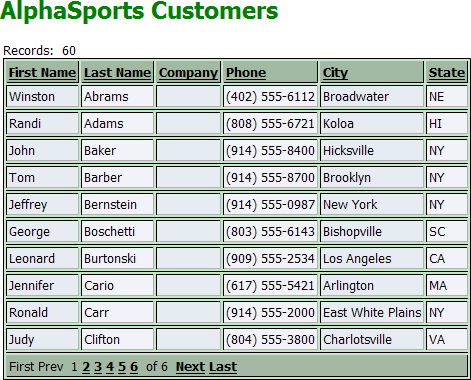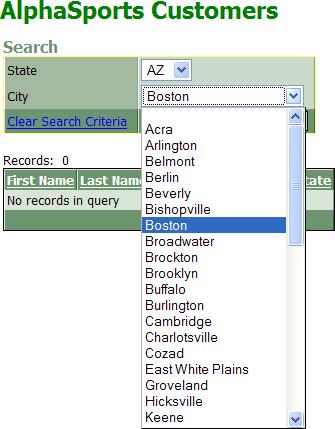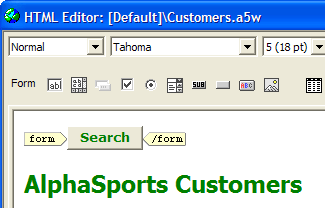Using a Dialog as a Search Form
- Putting it Together
- Control Settings > Control Type
- Value
- Define Choices > List Type
- Value
- DropDownBox Properties > Choices > Data Source > Data source type
- Value
- DropDownBox Properties > Choices > Data Source > Table name
- Value
- DropDownBox Properties > Choices > Data Source > Display value field
- Value
- Control Settings > Control Type
- Value
- Define Choices > List Type
- Value
- DropDownBox Properties > Choices > Data Source > Data source type
- Value
- DropDownBox Properties > Choices > Data Source > Table name
- Value
- Running the Pages
Description
Assume you have a grid that shows all the records of a table, such as the following.
If you wanted to search for all of the customers in a specified city and state, you could add a search part to the grid. The following search part has two drop down list boxes that display the unique field values from the state and city fields.
Unfortunately, there is no way for the search part to display only valid city entries for the specified state. A solution is to use a dialog component on a different page as a search form.
Putting it Together
Add an advanced button to the page containing the grid. This button will open the page that contains the dialog search form.
The page that contains the dialog search form is named customer_filter.a5w. The form is named filt. The modifications to the form and button code is as follows.
<form method=post name="filt" action="customer_filter.a5w" ><button id=button_adv1 name=button_adv1 onclick="document.forms'filt'.submit()" ><strong><font face=Verdana color=#008000>Search</font></strong></button></form>
The dialog component that is placed on customer_filter.a5w has two drop down list boxes. The state control is based on the bill_state_region field of the customer table. Its properties are as follows:
Control Settings > Control Type
Value
DropDownBox
Define Choices > List Type
Value
Dynamic
DropDownBox Properties > Choices > Data Source > Data source type
Value
DBF-Table
DropDownBox Properties > Choices > Data Source > Table name
Value
customer
DropDownBox Properties > Choices > Data Source > Display value field
Value
bill_state_region
The city control is based on the bill_city field of the customer table. Its properties are as follows:
Define the parameter mapping for bill_state_region on the Parameter Mapping tab of the Filter Expression dialog:
- Property
- Value
- Parameter maps to a
Variable
- Variable name
State
- Parameter type
character
Select the Form > Properties page of the menus.
In the Server Events > AfterValidate field click the '...' button to display the Form Events dialog. Enter the following code and click OK. In this case the name of the grid component on the customers.a5w page is cust.
The expression placed into the filter variable has to be a valid expression for the database you are using.Code for DBF table.
dim filter as C filter = "bill_state_region = " + quote(state) + " .and. bill_city = " + quote(city) filter = urlencode(filter) currentform.redirecttarget = "customers.a5w?cust_filter=" + filter
Equivalent code for a SQL database.
dim filter as C filter = "customer.bill_state_region = '" + state + "' and customer.bill_city = '" + city + "'" filter = urlencode(filter) currentform.redirecttarget = "customers.a5w?cust_filter=" + filter
Finally, you need a second button to clear any search filter that you have imposed on the customers.a5w page. Create a second advanced button (as described in steps 1 and 2), name it clear, and modify its <form> and <button> code as follows. The filter expression indicates that all records are to be displayed.
<form method=post name="clear" action="customers.a5w?cust_filter=.t." ><button id=button_adv1 onclick="document.forms'clear'.submit()" name=button_adv1><strong><font face=Verdana color=#008000>Clear Search</font></strong></button></form>
Running the Pages
The initial view of the customers.a5w page is as follows.
images/WPT_Dialog_as_Search_Form_5.gif
After clicking Search and entering values into the search form, you see the following.
images/WPT_Dialog_as_Search_Form_6.gif
After clicking Submit, the filtered customers.a5w page reappears.
images/WPT_Dialog_as_Search_Form_7.gif
See Also



